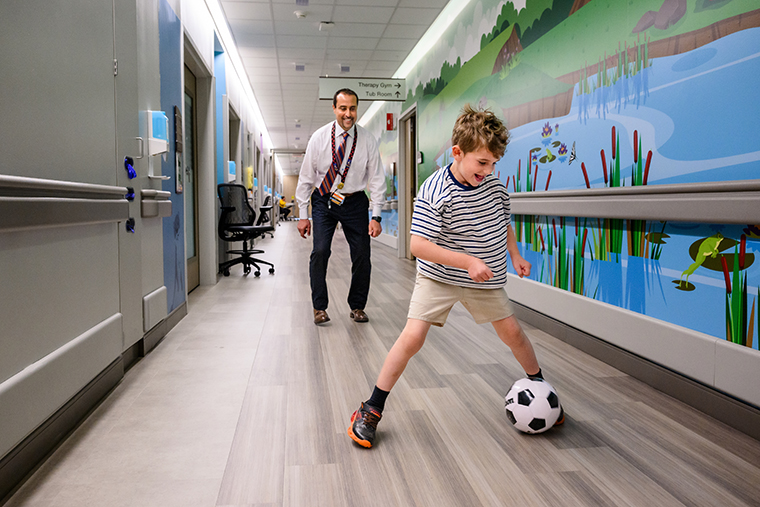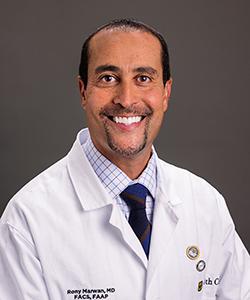It would be stretching the truth a little to say soccer is in Bronson Schwenker’s blood.
He loves the sport, that much is true. The 6-year-old Kansas City resident will confidently tell his parents, Krystal and Ben, that he’s going to score five goals that day, and then go do it. He has fun whether he’s playing with, or against, his younger brother, Crosby. But his start in the sport wasn’t necessarily his decision.
“Soccer was a little bit of a parent choice sport,” Krystal said. “He has a lot of energy, and soccer is a safe way to burn it. He’s really good at it, so I’m very glad he enjoys it.”
Bronson is the kind of high-energy kid who’s hard to keep an eye on and harder to tire out. At a friend’s birthday party, he discovered rock climbing was something he wanted to try, which came as a surprise to his parents.
“I knew he wasn’t going to be a golfer or a swimmer,” Krystal said. “That’s not my kid. He’s jumping off the sofa. He’s very rambunctious. Just a wild child.”
Bronson’s energy is a blessing for Krystal and Ben now, because he didn’t always have it.
Krystal was born with a genetic blood disorder called hereditary spherocytosis. She knew she might have passed it on to Bronson and that there are no reliable tests for the condition until a child reaches their first birthday.
Mom and dad kept a close eye on Bronson during those first 12 months. Eventually, testing confirmed what their son was experiencing: He had the condition as well.
“I learned a lot from Krystal,” Ben said. “She prepared me for the fatigue and reduced appetite from anemia, for the jaundice symptoms. She knew how important certain supplements were, and from the time he was a newborn, she prepared me that the first four or five years would be tough.”
Spherocytosis is a blood condition in which some red blood cells have an abnormal shape. They look spherical, like a soccer ball, rather than indented in the middle like a frisbee. These spherocyte red blood cells are damaged more easily and need to be broken down more often in the spleen.
That process leads to anemia because spherocytes are destroyed more quickly than new red blood cells are created. Anemia increases the risk of severe illness — especially in young children — and there are other health risks that can develop because of the condition.
“Hereditary spherocytosis is the most common non-sickle cell hemolytic disease in the United States,” said Alicia Bach, MD, a pediatric hematologist and oncologist at MU Health Care. “Severe anemia is the biggest risk initially for kids because it can lead to heart failure.”
Bronson received two blood transfusions before he was six years old. Some days were good, and others he complained of abdominal pain or had worryingly yellow skin from jaundice. Even with low energy, Ben and Krystal had to watch Bronson closely because any falls might rupture his spleen, which had enlarged to process his defective red blood cells.
Bronson’s second transfusion didn’t help him rebound the way he had after the first. His pain got worse, tummy aches elevating to a level Krystal hadn’t seen before. She decided to get a second opinion in Columbia and the two arrived at Children’s Hospital after midnight in August of 2024. At first, Krystal questioned whether she’d made the right decision.
“I had to decide in that moment whether it was worth it to get on I-70 at night with a crying kid,” Krystal said. “Thankfully, my family in Columbia knew a little bit about MU Health Care’s pediatric hematology department. But I told myself I was going to do everything I could for my kid, and this was my chance to prove that to him.”
In Columbia, Dr. Bach, pediatric surgeon Rony Marwan, MD, and pediatric hematology nurse clinician Cara Hirner waited to receive Bronson and Krystal.
Tests revealed a concerning explanation for Bronson’s pain. He had gallstones — a rare condition for someone his age — caused by too much bilirubin, a pigment byproduct of red blood cells breaking down in his spleen. That constant work to break down blood cells caused Bronson’s spleen to grow to 17 centimeters, larger than that of an adult man.
After making sure Bronson was comfortable and not in pain, Dr. Bach and Dr. Marwan met with his parents to outline their recommended care plan.
“Not every hereditary spherocytosis patient will need their spleen out,” Marwan said. “But Bronson's spleen had enlarged outside of his ribcage and had stretched its capsule. Eating and general activity caused him a lot of pain and also put him at risk of a rupture. His gallstones increased his risk for an inflamed gallbladder and pancreatitis, so we proposed removing his gallbladder during the same procedure.”
Krystal and Ben were relieved to hear that surgery was an option for Bronson. Krystal had had her own spleen removed — she has a scar from her abdomen to her back — and has family members who have lived past the age of 70 without a spleen.
“I literally cried when they said they were going to take his spleen,” Krystal said. “I am so thankful for his care team, because it’s like I have a new kid. There's a part of my heart that was healed by the doctors here who listened. I feel like they saved my kid, and they changed our family because we just get to parent Bronson now.”
One added benefit for Bronson is that surgical techniques have improved. Marwan used a single-incision laparoscopic approach, hiding the scar away inside Bronson’s belly button. It’s nearly invisible unless you know exactly where to look.
“The family was very grateful for our unified, team-based approach, and that’s kudos to our amazing institution and teams that create great outcomes for our patients,” Marwan said. “Part of that is being able to offer surgeries that don’t leave visible scars while achieving the same result and outcome.”
And Bronson, normally a shy kid with a fear of needles, became a boy excited to see his doctors and nurses in Columbia, asking his parents when he could see them next.

“We came to Columbia because we felt like the support was here, and the conversations were uplifting and encouraging,” Ben said. “Being from Kansas City, they coordinated in ways that spoke volumes to Krystal and I, and the relationships they made with us, but also with Bronson, gave everyone trust and confidence that he would come out of this feeling better.”
Bronson needed one night under observation in the hospital and a few weeks of taking it slow at home before he was cleared for regular activity. He quickly began making up for lost time.
His newfound energy keeps him going from 7 a.m. to bedtime, playing with Crosby, tearing up the soccer pitch and being a happy, energetic and carefree boy.
“It's a big deal for our family, and it will be a big deal for Bronson forever,” Krystal said. “There’s no longer that fear he’s going to hurt himself. I don't have to say no to my kid. I can say, ‘Yes, you can do the things that you are interested in.’ And I don't know what lies in his future health journey, but I do feel confident that it will be good enough to say this changed the game for him. It changed the game.”




